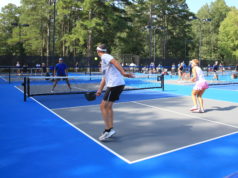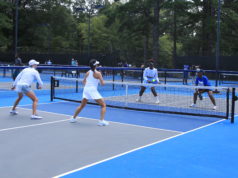9 Nutritional Tips to Start Your Next ALTA Season Off With a Bang
By Page Love, M.S., R.D., CSSD, USPTA
So another holiday season has just passed you by and you are feeling a little sluggish and are moving a bit slower on the court. Maybe an injury has sidelined you like me, but no worries. It is time to get back at it and get back on that court — the place you love to be — but you want to be leaner and faster, and you want to hit that ball with more power than last season. Well, here are 10 tips that may help you get there, nutritionally at least.
Forget low-carb diets this year: If you are a going to make it through your next grueling three-set ALTA match, you can’t afford to do it on empty. You have to choose good quality fuel for your engine, which means high-density complex carbohydrate foods. Choose complex carbohydrates such as high fiber cereals, whole grain breads and rice, whole grain pastas and ancient grains. Make sure you have a choice at every meal. For example, try oatmeal for breakfast, whole grain wraps for lunch and quinoa for dinner.
Hydrate, hydrate, hydrate all day long: Most tennis players do not do very well in this area — to the tune of 50 percent of where they should be on hydrating adequately. Try drinking one hydrating cup of fluid per hour, or about 4-8 ounces at each changeover during a match. Rather than reaching for another cup of caffeinated coffee, choose a decaf coffee for your second choice. Decaf beverages will hydrate you, so think twice before you consume caffeine in the later hours of the workday. Water is preferable during the day, but don’t forget food group beverages will count toward your fluid intake, too, such as milk or fruit or vegetable juices, or smoothies. As you get closer to play time, focus back on water or consider electrolyte waters such as Propel, PowerAde Zero or Gatorade.
Consume lots of colorful produce in your meals during the day: Aim for something colorful at every meal to maximize antioxidant and anti-inflammatory benefits from your foods. Try to pick more red produce, such as berries, cherries and tomatoes. These contain a phytonutrient called anthocyanin that helps shorten the window related to the delay of onset muscle soreness after intense play. Also, choose more bright yellow and oranges for vitamin C and beta-carotene, which keep your immune system strong and resistant to respiratory infections especially during the wintertime. And don’t forget about your deep greens for good sources of B vitamins, known as “energy vitamins,” and important minerals such as iron and calcium.
Meet your calcium and vitamin D needs with high quality dairy to help with immune and bone health: Choosing three dairies per day is the goal to meet your minimum calcium needs. Cow’s milk and Greek yogurt are two excellent staples to help meet these requirements. If you are lactose intolerant or vegetarian, choose a high-calcium and protein-packed dairy alternatives, such as organic almond milk or ripple pea protein milk. Most other options do not replace both the protein and the calcium. Dairy protein is also a very stabilizing part of the pre-match meal and can be both a great snack and important recovery choice for tennis play.
Eat a high-energy pre-play or pre-match meal: This meal should be predominantly high carbohydrate, but should also contain a lean protein source and a dab of healthy oil to hold you until close to playtime. Before morning matches, great choices for breakfast may include a bagel with peanut butter and a banana; a moderate to lower fiber cereal such as Multigrain Cheerios with a side of peanut butter toast; or waffles with a single egg and fruit bowl. For lunch meals before after-school or work-play choose lean meat sandwiches, burrito bowls or chunky meat and starch-based soups. This meal should be consumed ideally three hours prior to playtime. If you have less time, adjust volume to be lighter. Avoid extremely high fiber choices such as very high fiber cereals or large servings of lentils because these can lead to digestive discomfort both on and off the court.
Make sure to get a high-carb snack before you play: This is especially important if you have gone three to five hours since your last meal and you are leaving work to go to hit or play an ALTA match. You need an energy burst and this is not the time to drink a Red Bull or 5 Hour Energy Drink. Your body needs quick muscle energy and preferably energy in the form of a balanced snack that will help you stay energized on the court. Your best choices will be salty, grainy snacks like pretzels and string cheese; trail mix that contains nuts, cereal and dried fruit; or an energy bar such as Luna or Kind or the new nut-butter-filled Clif Bar or Pro Bar Snack bars. Time these snacks about an hour before you hit the court and you will have a nice natural food energy boost that will last your whole practice or match.
As you come off the court, have a recovery nutrition strategy. Continue to hydrate with your on-court beverage of choice, but plan on getting a quickly absorbable form of protein within 30 to 45 minutes of play or workout time. The most popular current beverage of choice on major tennis tours is chocolate milk. The cold, light and easily digestible protein source is hydrating and full of carbohydrates. If you are trying to gain muscle weight or are a young player going through a growth spurt, a slightly higher protein beverage such as a smoothie or fortified dairy option like Core Power, Muscle Milk or Organic Fuel may be an appropriate option. You can also continue to hydrate as encouraged above and try to eat a protein source such as a sandwich or peanut butter crackers with your hydrating beverage.
Don’t be afraid of salt. If you are a competitive ALTA player, you may be losing lots of salt in sweat — to the tune of 5,000-10,000 milligrams per day. Don’t be afraid to lightly salt your meals and focus on visibly salty foods such as pretzels or salty liquids like tomato juice or broth-based soups. Enjoy those salty, brothy soups at lunch before you play. Try chicken noodle or tomato soup. Enjoy pickled veggies such as pickles, pickled green beans or a new product line called Oh Snaps featuring pickled carrots. Use salty condiments such as mustard, ketchup and barbecue sauce with ease. They contain lots of sodium!
Experiment with sport foods to help meet your sport performance needs: Don’t hesitate to take a sports beverage with you on the court, especially as the weather starts to warm back up again in spring. Try gels and chews on court during long matches, especially during the second hour of play and longer. Try these during the changeover with your water or sport beverage. These are particularly helpful when your energy levels are dropping and when you feel like you are hitting a wall. Bite-size pieces of energy bars or granola bites may work well in this instance, too. Try these out before match play and during longer practices to see what works best for you on court.
_______
Page Love is a consultant for the ATP and WTA professional tennis tours and a member of USTA Sport Science Committee. For more information, contact her at nutrifitga.com.




